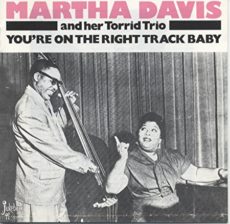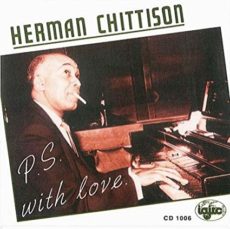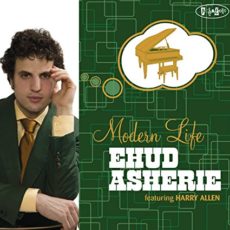
Daily Dose Of Jazz…
Martha Davis was born on December 14, 1917 in Wichita, Kansas, and was raised in Chicago, Illinois. By the mid-1930s, she had met and been influenced by Fats Waller, and performed regularly as a singer and pianist in Chicago clubs. In 1939, she met, and later married, bassist Calvin Ponder, who went on to play in Earl Hines’ band.
In 1948, Davis moved to California, and developed her recording career on Jewel Records in Hollywood with a trio including Ponder, guitarist Ralph Williams and drummer Lee Young. Their cover of Dick Haymes’ pop hit Little White Lies followed by a duet with Louis Jordan, Daddy-O in 1948, reached # 11 and #7, respectively, on the Billboard charts.
Davis and Ponder also began performing together on stage, developing a musical and comedy routine as “Martha Davis & Spouse” which played on their physical characteristics, she was large, he was smaller. The act became hugely popular, touring and having a residency at the Blue Angel in New York City. They appeared together in movies including Smart Politics with Gene Krupa, and in the mid-Fifties, variety films Rhythm & Blues Revue, Rock ‘n’ Roll Revue and Basin Street Revue. Several of their performances were filmed by Snader Telescriptions for video jukeboxes, and they also broadcast on network TV, particularly Garry Moore’s CBS show.
In 1957, after a break of several years, they resumed recording for the ABC Paramount label, with whom they cut two LPs. Singer and pianist Martha Davis passed away from cancer in New York on April 6, 1960 at age 42.

Daily Dose Of Jazz…
Herman Chittison was born on October 15, 1908 in Flemingsburg, Kentucky. Known as Ivory in the jazz world he began his career in Zack Whyte’s territory band in Ohio in 1928. In the early Thirties he moved to New York City and found work as an accompanist to Ethel Waters, Adelaide Hall, and Clarence Williams. It was during these years that he visited Boston for the first time with a traveling show headlined by comic actor Stepin Fetchit.
In late 1933 he went to Europe with the Willie Lewis Orchestra and toured Europe and the following year he recorded with Louis Armstrong in Paris, France. Chittison and trumpeter Bill Coleman left Lewis in 1938 and formed a band that worked extensively in Cairo, Egypt and traveled as far east as India. The two musicians would later lead the Harlem Rhythm Makers.
By 1959 Ivory arrived in Boston for a stay of two years and took up residence as the house pianist at the Red Garter bar in the Lenox Hotel. He then moved to the Mayfair Lounge, in Bay Village. He was one of the earliest and most important ambassadors of American jazz in Europe.
Stride pianist, accompanist and virtuoso Herman Chittison, whose style and technique were very similar to Art Tatum, passed away on March 8, 1967 in Cleveland, Ohio.
More Posts: piano

Daily Dose Of Jazz…
Teddy Weatherford was born on October 11, 1903 in Pocahontas, Virginia and was raised in neighboring Bluefield, West Virginia where he learned to play the piano. But it was while living in New Orleans, Louisiana from 1915 through 1920, that he learned to play jazz piano.
Moving to Chicago, Illinois he worked with the bands of Erskine Tate through the 1920s and with such jazz notables as Louis Armstrong and Johnny Dodds and impressed the young Earl Hines. Restless to experience the world, Weatherford then traveled, first to Amsterdam and then around Asia playing professionally. In the early 1930s, he led a band at the Taj Mahal Hotel in Bombay, now Mumbai, India. He joined Crickett Smith’s band in Jakarta, Indonesia and took over leadership of Smith’s band in Ceylon, now Sri Lanka, in 1937.
During World War II, Teddy led a band in Calcutta, where he made radio broadcasts for the U. S. Armed Forces Radio Service. Performers with in his band included Bridget Althea Moe, Jimmy Witherspoon, Roy Butler and Gery Scott.
Pianist and bandleader Teddy Weatherford, who was also an accomplished stride pianist, passed away of cholera in Calcutta, aged 41, on April 25, 1945.
More Posts: piano

Daily Dose Of Jazz…
Ehud Asherie was born on December 20, 1979 in Israel and with his family moved to Italy at the age of three. He started playing piano at the age of seven and attended the Sir James Henderson School, now The British School of Milan, before they moved to the United States when he was nine. As a New York City teenager he visited Smalls Jazz Club, taking private lessons from Frank Hewitt, a pianist who often played there and attending the New School University.
Asherie first played at Smalls when he was a high school sophomore. In 2010 he recorded his debut solo piano album, Welcome to New York with a focus on stride and standards. The same year he played Hammond organ on his quartet release, Organic, mixing bop and swing with standards.
He has recorded seven albums as a leader ranging from duo to quintet group configurations on the Arbor and Posi-Tone labels. He has been a sideman recording with Bryan Shaw, Hilary Gardner and Harry Allen. He has performed with Peter Bernstrin, Joe Cohn, Billy Drummond, Bobby Durham, Frank Gant, Paul Gill, Jimmy Green, Dennis Irwin, Jimmy Lovelace, Joe Magnarelli, Bob Mover, Tim Pleasant, Ben Street and Mark Taylor.
Pianist and organist Ehud Asherie has for two years been playing regularly at Smalls with his own trio, the Grant Stewart Quartet and the Neil Miner Quintet. He has also served as a rehearsal pianist for the Village Vanguard Orchestra and Since January 2000 he’s part of Trio65 at New York City’s Rainbow Grill with bassist Joseph Lepore and drummer Tommaso Cappellato. He continues to perform, record and tour.
Sponsored By

Voices From The Community
![]()
More Posts: piano

Daily Dose Of Jazz…
Willie “The Lion” Smith was born William Henry Joseph Bonaparte Bertholoff Smith on November 25, 1897 in Goshen, New York. His biological father Frank Bertholoff was a light-skinned playboy who loved his liquor, girls, and gambling. His mother, Ida, threw Frank out of the house when William was two years old. After his father died, his mother married John Smith, a master mechanic from Paterson, New Jersey and Smith was added at age three.
In 1907, the family moved to Newark, New Jersey and when he was six discovered his mother’s piano in the basement and she taught him the melodies she knew. His uncle taught him to dance and subsequently he won a dance contest. It was at this time he decided to concentrate on music.
He attended the Baxter School, but after a theft incident involving a dime to see a traveling road show, he was transferred to Morton School in the sixth grade and then went on to Barringer High School, then Newark High, and attempted swimming, skating, track, basketball, sledding, cycling, and boxing to get the ladies attention. He also hung out with prizefighters like Jack Johnson, Jack Dempsey, Joe Louis, Gene Tunney and others, belong to a gang and eventually played piano in the back room of one of the members club.
Willie won an upright piano in a newspaper ad contest guessing the number of dots were in a printed circle. From that day forth, he sat down at the piano and played songs he heard in the clubs and saloons, including Scott Joplin’s Maple Leaf Rag by, Cannonball Rag by Joe Northrup, Black and White Rag by George Botsford, and Don’t Hit That Lady Dressed in Green, She’s Got Good Booty and Baby, Let Your Drawers Hang Low. By the early 1910s he was playing in New York City and Atlantic City, New Jersey.
Serving in World War I and seeing action in France, Willie played drums with the African-American regimental band led by Tim Brymn and played on the regimental basketball team. Legend has it that his nickname “The Lion” came from his reported bravery while serving as a heavy artillery gunner and he was a decorated veteran of the Buffalo Soldiers 350th Field Artillery regiment. Following the war he returned to work in Harlem clubs and at rent parties as a soloist, in bands or accompanying blues singers like Mamie Smith. Smith and his contemporaries James P. Johnson and Fats Waller developed a new, more sophisticated piano style later called “stride”.
By the 1940s his music found appreciation with a wider audience, and he toured North America and Europe up to 1971. He was at the taking of the jazz photograph A Great Day in Harlem in 1958, however, he was sitting down resting when the selected shot was taken, leaving him out of the final picture. The Lion was also an educator teaching privately and his students included such notable names as Mel Powell, Brooks Kerr, and Mike Lipskin. Although working in relative obscurity, he was a “musician’s musician”, influencing countless other musicians including Duke Ellington, George Gershwin, and Artie Shaw.
Duke Ellington demonstrated his admiration of the pianist by composing and recording the highly regarded “Portrait of the Lion” in 1939. In his later years, Newark, New Jersey honored him with Willie “The Lion” Smith Day, and Orange County, New York also proclaimed September 18th as Willie “The Lion” Smith Day, that was also the date of the first Goshen Jazz Festival.
Willie “The Lion” Smith passed away at the age of 79 on April 18, 1973 in New York City.

More Posts: piano




